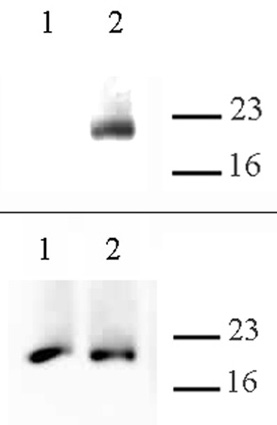Histone H3.cs1 antibody (pAb)
Host / Isotype
Rabbit / Serum
Reactivity
Human
Applications
WB
Cat No : 39573,39574 39573
Synonyms
Validation Data Gallery
Product Information
| Tested Applications |
WB
Applications Validated by Active Motif: WB: 1:500 - 1:1,000 dilution Depending upon the gel system employed, a change in mobility of the clipped form of histone H3 may not be observed. |
| Tested Reactivity | Human |
| Host / Isotype | Rabbit / Serum |
| Class | Polyclonal |
| Type | Antibody |
| Immunogen | This Histone H3.cs1 antibody was raised against a peptide containing the site of Cathepsin L cleavage at the N-terminus. |
| Full Name | Histone H3.cs1 antibody (pAb) |
| Synonyms | histone, histone H3, histone H3.cs1, H3.cs1, Cathepsin, Cathepsin L, embryonic stem cell, stem cell, ES cell, ESC, differentiation, pAb, polyclonal, antibody, antibodies, hisvar, sample |
| Molecular weight | 15 kDa |
| GenBank accession number | NP_003522 |
| RRID | AB_2793264 |
| Purification Method | None |
| Buffer | Rabbit serum containing 30% glycerol and 0.035% sodium azide. Sodium azide is highly toxic. |
| Storage | Some products may be shipped at room temperature. This will not affect their stability or performance. Avoid repeated freeze/thaw cycles by aliquoting items into single-use fractions for storage at -20°C for up to 2 years. Keep all reagents on ice when not in storage. |
Background Information
Histone H3 is one of the core components of the nucleosome. The nucleosome is the smallest subunit of chromatin and consists of 147 base pairs of DNA wrapped around an octamer of core histone proteins (two each of Histone H2A, Histone H2B, Histone H3 and Histone H4). Chromatin is subject to a variety of chemical modifications, including post-translational modifications of the histone proteins and the methylation of cytosine residues in the DNA. Reported histone modifications include acetylation, methylation, phosphorylation, ubiquitylation, glycosylation, ADP-ribosylation, carbonylation and SUMOylation; these modifications play a major role in regulating gene expression. Histone H3 is proteolytically cleaved at its N-terminus by Cathepsin L during the differentiation of embryonic stem cells. It is possible that this processing occurs in order to remove modifications that serve as protein recognition elements (e.g. Histone H3 trimethyl Lys9) present in the extreme N-terminus.

